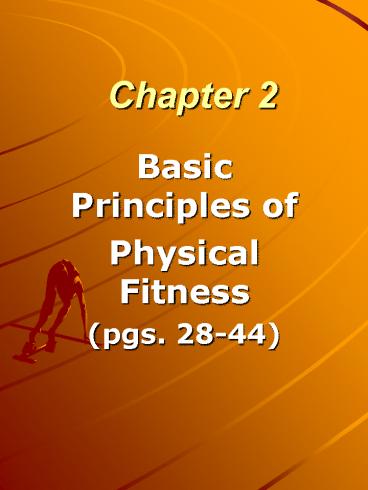Basic Principles of - PowerPoint PPT Presentation
1 / 22
Title: Basic Principles of
1
Chapter 2
- Basic Principles of
- Physical Fitness
- (pgs. 28-44)
2
Physical FitnessA set of physical attributes
that allows the body to respond or adapt to the
demands and stress of physical effort.
3
Exercise
- Planned, structured, repetitive movement of the
body designed to improve or maintain physical
fitness.
4
Physical Activity
- Any body movement carried out by the skeletal
muscles and requiring energy.
5
Health-Related Components ofPhysical Fitness
- Cardiorespiratory Endurance
- Muscular Strength
- Muscular Endurance
- Flexibility
- Body Composition
6
Cardiorespiratory Endurance
- Is the ability to perform prolonged,
large-muscle, dynamic exercise at
moderate-to-high levels of intensity.
7
Aerobic Depends on the presence of
oxygenAnaerobic Occurs in the absence of
oxygen
8
Muscular Strength
- Is the amount of force
- a muscle can
- produce with a
- single maximum effort.
9
Muscular Endurance
- Is the ability of a muscle or muscle group to
remain contracted or to contract repeatedly for a
long period of time.
10
Flexibility
- Is the ability to move the joints through a full
range of motion.
11
Body Composition
- Refers to the proportion of fat and fat-free mass
- (muscle, bone, water)
- in the body.
12
ACSMs 1998 Position StandRecommended Quantity
and Quality of Exercise for Healthy Adults
- Cardiorespiratory Endurance
- Mode Any activity that uses large
- muscle groups, is continuous
- and rhythmical (run, walk, swim,
- bike, row, climb, dance)
- Frequency 3-5 days per week.
- Intensity 60-90 of max heart rate.
- (est max HR 220-age)
- Duration 20-60 minutes of continuous aerobic
activity. - Resistance Training
- One set of 8-12 reps of 8-10 exercises for all
major muscle groups 2-3 days/wk. - Flexibility Training
13
- 25 of U.S. adults are not active at all.
- More than 55 of U.S. adults do not engage in
recommended amounts of physical activity. - Less than 20 of the U.S. adults engage in
recommended amounts of physical activity.
14
The 1996 U.S. Surgeon Generals Report on
Physical Activity and Health.
- Every American should accumulate
- at least 30 minutesof moderate-intensity
physical activity on most, if not all, days of
the week. - Supported by the ACSM, CDC, AHA, NIH.
15
Because of the Increase in Obesity, Additional
Guidelines Were Developed for Weight Loss and
Weight Management
- 45-90 minutes/day of physical activity
- Institute of Medicine, 2005 Dietary Guidelines
for Americans, World Health Organization,
16
Principles ofPhysical Training
- Specificity
- Progressive Overload
- Reversibility
17
Specificity
- To develop a particular fitness component,
exercises must be performed that are specially
designed for that component.
18
Progressive Overload
- Frequency
- Intensity
- Time
- Type
19
Reversibility
- The body adjusts to lower levels of physical
activity the same way it adjust to high levels. - Upon stopping exercise, up to 50 of improvement
can be lost within 2 months.
20
Guidelines For Training
- Train the way you want your body to change.
- Train regularly.
- Get In shape gradually.
- Warm up before exercising cool down afterwards.
- Exercise safely.
- Listen to your body.
- Cycle the volume and intensity.
- Try training with a partner.
- Train your mind.
- Fuel your activity appropriately.
- Add variety and have FUN!
- Track your progress
- Keep your exercise program in perspective.
21
Warming Up Cooling Down
22
- End of slides for lecture Day 2































